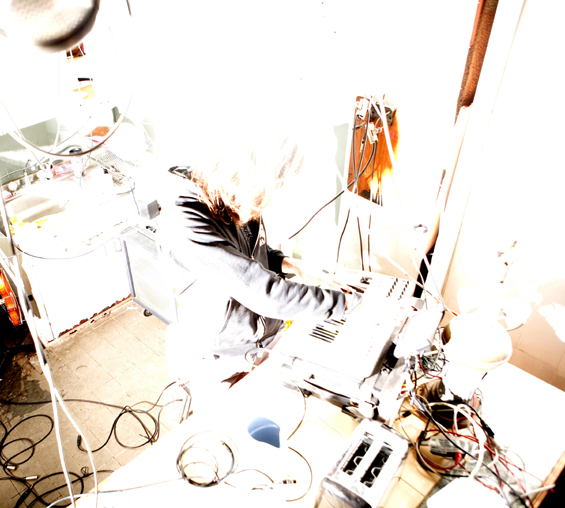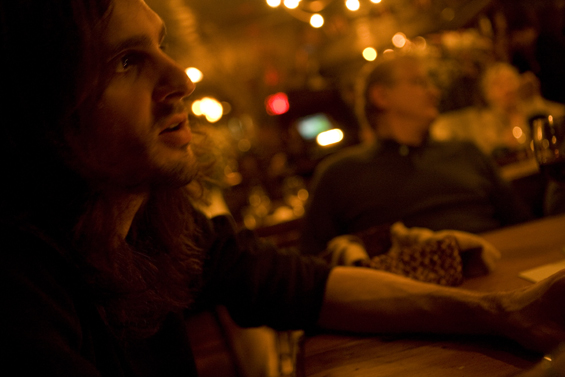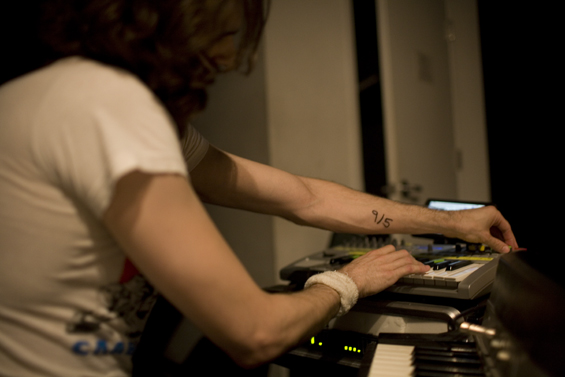

TEN QUESTIONS WITH CHRISTOPHER TIGNOR
photos: Jared Bell and Taylor Ruby (top), Katya Pronin (below)
Violinist, software designer, and leader of the NY-based Slow Six ensemble, Christopher Tignor brings an uncommon intelligence to his group's distinctive fusion of post-rock, electroacoustic, and chamber classical music. Extending the sonic potential of his violin playing using custom-designed software (Mnemonica and StreamSequencer), Tignor pushes his music into previously uncharted realms on the group's Private Times in Public Places (self-released on If.Then.Else in 2004; issued on Western Vinyl in 2007) and Nor'easter (New Albion, 2007), and on his solo album Core Memory Unwound (Western Vinyl, 2009) where he's joined by fellow violinist Colin Jacobsen and pianist Margaret Kampmeier. Born in Morristown, New Jersey in March 1976, Tignor eventually became proficient in using computer music techniques while studying under Richard Teitelbaum at Bard College, subsequently completed a degree in Computer Science at New York University while establishing Slow Six as a vehicle for his compositional and sound design explorations, and after NYU completed a doctorate in Music Composition at Princeton (though he's still finishing his thesis). Core Memory Unwound adds an arresting new wrinkle to his conceptual approach by pairing relatively unaltered acoustic settings with live “remixes” (dubbed “memory portraits”) that feature real-time sampling and sound transformation triggered by a keyboard controller. In a recent interview Tignor discussed the project in greater detail along with sundry other matters of concern to the modern-day composer.
1. You obviously stand out as an innovator in the—I hesitate to use “classical” for all the connotations it brings with it—“modern composition” field in your integration of software into the production and compositional process, something that's standard practice in experimental electronic music-making but less established as a practice in other areas. While obviously you and Nico Muhly come to mind as a new generation of composers who have embraced such possibilities, how broadly is that sensibility shared and how integrated are such practices at the moment?
I think there is something particular going on with so-called contemporary classical music and how it is finding its place in the current musical landscape. The listening population itself is in many ways more open to instrumental and experimental music than it has been in quite some time. This is a trend that of course has been developing for a while amidst the indie-experimental end of things. The same can't be said for the traditional classical outlets—if an incredible label like New Albion feels the need to stop making new titles, something is really wrong. That label always was about seeking the next adventure—very different from the usual fare of classical labels that are basically catalog houses for the established legacy. But that scene is the opposite of vibrant and is really very out-of-touch with current developments among this new world of younger artists. So real happening-now art-music is finding a home in the now more adventurous avenues of indie-experimentalism. Nico's music on Bedroom Community and Brassland is another example of this beside my own release and probably numerous others that have crossed your way.
2. It's interesting that, though you note how out-of-touch some established classical labels are, Deutsche Grammofon recently surprised members of the experimental electronic and classical communities by having Carl Craig and Moritz Von Oswald “recompose” three pieces, Ravel's Bolero and Rapsodie Espagnola and Mussorgsky's Bilder einer Ausstellung, taken from an 1987 recording of the Berlin philharmonic orchestra conducted by Herbert von Karajan (issued under the title Recomposed Vol. 3). What's your take on this kind of idea? Should such a gesture be seen as a serious attempt by DG to become more in touch or at least to be seen as being so, or is it little more than a novelty idea?
These sort of ideas in and of themselves are usually aesthetically neutral—it's the music itself that determines whether the idea is more of a marketing stunt than an aesthetic statement. I haven't heard the DG release so I can't speak to it specifically. Reich Remixed was another possibly comparable idea though that one that seemed much clearer in its attempt to win a wider popular audience to the art-music at hand. I don't think this sort of thing essentially changes anything for art-music at large. It just splices off a sliver of that culture that might be more easily digested by a popular audience—a process which nearly always side-steps the real thrust of these works—like the way Tin Pan Alley watered down their jazz and blues sources to make songs anybody could sing and play at home so they could sell sheet-music. Cultural signal loss. But with all this stuff you just have to take the music case by case; if good results come out of it, fantastic. Take good music where you can get it.
3. Aside from yourself and Muhly, who else do you see as important figures spearheading the music's development in directions such as these?
I think there is now a whole generation of composers that feel their music is very connected to both popular musical idioms and live electronics in more than just a passing off-hand reference. This is perhaps the first generation that feels truly comfortable in this context, with their music side-by-side with a band like Tortoise, for example. Because these developments feel so new, only time will tell who will really have the staying power to stick it out long-term as an artist and who will hole up with a teaching job, rarely to be heard from again. In art-music staying power is really vital—the need to have your language work its way into your audience over time. The comforts of Academia are still sort of a siren song in that regard unless you land something really extraordinary with enough free time and support.
My own aesthetics have always put me in alliance with anybody choosing live sampling over canned sound at their shows. It takes guts to do away with the safety net but if done for the right reasons and in the right way, the results are worth it. Folks often come up to me after shows telling me how they appreciate the live-ness of the electronics. Using fixed “tape” parts live at art-music gigs just almost always feels so 1950's Columbia music-concrete. There's a lot of that baggage still to get over for composers reared in that domain want to make engaging live music but more and more people are choosing to do live shows live; it's getting easier to pull off.
4. I wholly concur with your embrace of live sampling over pre-programmed tracks. The real question is why your approach isn't more the rule than the exception, given how deadening an impact cueing canned tracks has on a performance. My own impression is that the anticipated inroads innovative experimental electronic was supposed to make into mainstream culture a number of years ago didn't happen in part because of such DOA “live” presentations. Given that software like Mnemonica certainly makes real-time live sampling an easier proposition, I'm wondering if you're its exclusive user or is it now being used by others too?
Well, of course I hope other people will make use of the software I've built or even build their own if they're so inclined. But I think the real target for my software instruments is an entirely new evolving kind of musician: the live electronic musician. This is really a specialist role—like being a professional pianist—that is still finding a legitimate spot in musical culture. My tools are likewise not for the everyday casual user; you have to be comfortable with the gear, tools, and ways of thinking natural to performing electronic musicians.
I think the reason doing things this way isn't the norm is simply because it's much more practically challenging. It's pretty hard to rehearse your part alone when your sound requires live sampling another player. Considering most art-music concerts can only afford a very small number of rehearsals with all the hired players, live sampling becomes pretty impractical. The whole scene is set up so that people can learn their parts completely individually and then put together the ensemble elements in a few hours. That's why I started Slow Six, because I knew that to do live sampling in a meaningful way, it would take more time. People really interested in this stuff should probably just start their own bands. Also you need to be both super-diligent with your preparation and psychologically prepared for the many idiosyncrasies which are bound to happen with any live experimentalism. Not a lot of folks are up for rolling with the punches in front of a big crowd when things start going left when you were expecting them to go right.

5. I'm also curious about how venues factor into all this. Obviously Steve Reich's ensemble can perform at BAM and Glass can have Satyagraha presented at the Metropolitan Opera but how do up-and-coming composers get their music across to the concert-going public? Certainly places such as Manhattan 's Le Poisson Rouge and Brooklyn 's MonkeyTown are wonderful avenues but can they make an impact strong enough to help new artists get over?
Not by themselves they can't. Foster Reed from New Albion told me that when Reich and Glass were young they basically got in the car and never got out. Maybe they were thinking more like popular musicians in that way? Touring and making records is still the best way to get your music out there it seems. Nothing replaces the impact of having folks see you live and leave with some CDs or vinyl. But very few folks in the classical scene seem up for the lifestyle that requires. You can't really have a salaried gig if you need to be gone for a few weeks on the road. Live electronic musicians need to be prepared to get their sound across even in some random club set-up, just like the guitar player does.
6. What changes in thinking do you think the established classical labels need to adopt in order to help support the music's evolution?
Basically, the thinking by these new classical artists in the now is simply more in tune with what adventurous popular labels, and their corresponding music-makers, seem to be about, in particular: still feeling excited about the possibility of adventurous and sincere music really taking off (whatever that may mean)—in short, youthful exuberance. That's simply the opposite vibe I get from the handful of remaining classical labels with their often disregard for style and presentation and strong reliance on “music faculty I know”-attitude toward releases. I think labels run by folks interested in modern musical developments will begin reaching out to people in the popular music industry they never would have before as that's where exciting things are happening. Other folks who aren't interested in such developments will either spin their wheels and continue to be anachronistic or fade away. The results of reaching across the isle are really culturally rewarding I must say; I still find it amusing that Nor'easter and likely this new record will get covered by the indie stalwarts like Pitchfork alongside the new Yeah Yeah Yeahs record and the like. Several of the 2007 year-end “Best of” lists looked delightfully heterogeneous with our work slipped in between the usual suspects. There's something afoot.
Musically of course, the aesthetics of forward-leaning art-music certainly reflect its increasingly apparent home. The growing pains of much of the 20th century's modernism have now settled in. Now with some distance from those tumultuous (and often, but not always, wonderfully chaotic) beginnings, art-music is just starting to find a more natural connection to the rest of culture (musical and otherwise) surrounding it. It just really is a joke when you (rarely) hear some composer proudly tell you they're a serialist or something like that (or even some more modern music-data conceits). Such dogmatic ships have sailed; new vessels are underway.
7. It's not unusual for a musical project to focus on memory as a theme but you've handled it in a particularly unique way by presenting relatively straightforward “acoustic” pieces on your album with “memory portraits,” an idea that seemingly dovetails perfectly with your own software-oriented approach to the music-making process.
For me this was an important issue and challenge: trying to use the literal world of digital memory to create mnemonic portraits that variously captured, transformed, and/or free-associated with “key” elements as I identified them from the preceding acoustic works. Of course the striking power of memory is in how it can completely transform our life experiences in hindsight—the “errors” in recall or simply the revisionist attitude toward life time offers us (thankfully). One might consider the track “Core Memory Unwound” the “closest” memory to its preceding source music, as the mood is so close to the original that it's nearly a continuous piece. The other remixes are more distant memories; in particular, “Left in Fragments” maintains such a fragmented relation to its preceding work that it's perhaps like decades later in one's life catching a turn of phrase (those transposed looping violin harmonic melodies in the last section) that reminds one of a now-gone critical relationship, but little else to make the tie back to that former life, now re-engineered.
8. To what degree, if at all, was Core Memory Unwound inspired by the “memory works” of other composers (William Basinski's recordings obviously come to mind)? Or maybe a better was of putting it is to ask what other “memory” works, musical or otherwise, do you find inspiring?
Musically, not at all really. Like you've mentioned there's lots of great music out there on the theme, but it was really important to me to make my take on this very general topic very personal and specific, especially for music this abstract. This is the most personal record I've created, both in the nature of these violin and piano pieces and in the process of creating the memory portraits, which stems directly from my approach to using sampling software as a live instrument. I spent a lot of effort identifying what I felt were the violin and piano gestures that captured something intrinsic to the spirit of each work. It was something like composition in reverse: reverse-engineering my own music and then seeing where I could go with those sampled moments by playing my software.
One inspirational note is that the title of the last work (over two tracks), Cathedral, comes from the rather nostalgic poem Autumn from the late Polish poet Czeslaw Milosz:
“Cathedral of my enchantments, autumn wind,
I grew old giving thanks.”
9. Though Core Memory Unwound is naturally your major focus at the moment, I'm also aware that the third Slow Six recording is in the works and so am curious to hear a little bit about it too. Can you give us a hint of what to expect and when it will be released? How much of a cross-pollinating effect has there been between the two albums considering that they've been presumably worked on to some degree concurrently?
I just finished mixing the new Slow Six record a few days ago with John Congleton down in Dallas and I'm just so psyched on it. John just made the thing so overwhelming-sounding, and I made sure it still has all the nuance and detail our stuff is known for—a really great musical meeting. I have no idea when it will be out; hopefully not before too too long...
These two records are really distinct musically though which is part of the charm for me personally. The new Slow Six record is our unique perspective on our instrumental post-punk roots. It's still music that develops slowly over-time but there's lots of up-tempo tangled rhythms side by side with big, big ambiances. Also, with this newest Slow Six material I'm almost exclusively playing effected violin so there is relatively little software transformations on the record though no shortage of live electronic textures. So it was nice with Core Memory Unwound to really bring the focus for a bit back to my live software sampling.
10. I know you played on one of the pieces that (I believe) will appear on Alexander Turnquist's next album release. What other kinds of things have you got going on besides the two albums we've talked about?
One of the projects I'm most excited about is a new duo I started with the drummer from Slow Six, Theo Metz, called Wires Under Tension. Theo and I are connected through a whole network of midi and audio cables that let us feed into a system of connected software instruments I built. In addition to Theo on drums, I'm playing my software, Rhodes , and violin through some effects pedals. It's a sort of weird, bionic instrumental rock band and the most high-energy, up-tempo music I've written for a long while—downright athletic at points. Very different from this solo release, it's the other side of me.I also played a good deal of violin on the recently completed Lymbyc Systym record, Shutter Release (out in November on Mush) and have been playing some really fun live shows with them as well. They're a great bunch of dudes, incredible musicians, and super-fun to play with on-stage.

May 2009![]()